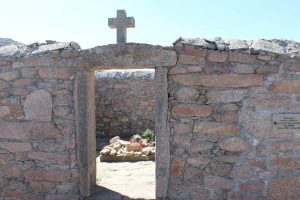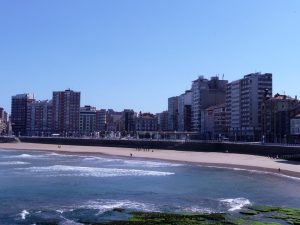
The Camino de Santiago boasts numerous routes, each with its own character, landscape and legacy. Among them lies a lesser-known yet deeply transformative path: the Camino del Mar. This variant follows the northern coast of Galicia and can be considered a section that links the Northern Way with the English Way.
Aside from being relatively unknown, it offers a distinct experience from the more popular routes such as the French or Portuguese Ways. Here, it’s not just about the destination – the journey itself takes centre stage: fishing villages, untouched beaches, ancient monasteries and the constant murmur of the Atlantic accompany pilgrims in their personal quest.
In this guide, we’ll walk you through this route in detail, although we must warn you that the content is purely informative. If you’re looking to book a Camino de Santiago trip with Mundiplus, please note that we do not operate this route.
Índice de contenidos [Ocultar]
Camino del Mar: a hidden gem in northern Galicia
The Camino del Mar is one of those routes that captivates pilgrims from the very first step – not only due to its scenic beauty, but also for its historical and cultural richness. Although it does not currently appear on the official itineraries recognised by the Pilgrim’s Office, it holds a legacy stretching back centuries, making it as authentic as any other route.
In fact, its origins date back to the Middle Ages. Sailors, merchants, and pilgrims from northern Europe would arrive by sea at Galician ports and travel along this coastline to join other paths leading to Santiago.
For centuries, this unofficial route has served as a natural corridor between Ribadeo and Ferrol, following the coastline of northern Lugo and A Coruña. As such, you can either start the Camino de Santiago from Ribadeo or walk in the opposite direction towards Ferrol.
For a long time, the route was largely forgotten due to lack of signage and limited information. However, in recent years it has seen a spontaneous revival thanks to the efforts of local associations, independent guides and pilgrims seeking more intimate trails.
Indeed, it offers a unique experience: untamed nature, characterful fishing villages, and a constant connection with the sea. Unlike routes like the French Way, you won’t encounter crowds or packed hostels here. That said, pilgrims must be more self-sufficient and plan well, as services are limited in certain stretches.
Moreover, this adventure does not grant the Compostela nor requires credential stamps.
A path of wild scenery and authenticity: a comparison with other routes
This trail crosses some of the wildest and most breathtaking landscapes of northern Spain. Dramatic cliffs, unspoiled beaches and centuries-old fishing villages make it one of the most beautiful routes for those who want to feel the Atlantic’s pulse throughout their pilgrimage.
It’s a less-travelled journey, allowing pilgrims to experience the Camino de Santiago in its most introspective and genuine form.
Compared to more popular trails like the Northern Way, this variant offers a more isolated and less urbanised environment. For example, the Camino de Santiago from Bilbao allows pilgrims to enjoy major cities, abundant services and accessible beaches. In contrast, the Camino del Mar stands out for its rustic charm, with each stage offering an adventure between mountains and sea.
Unlike the Portuguese Way, known for its convenience, clear signage and hospitality, this route is a more demanding, yet quieter and more spiritual alternative. On the Camino de Santiago from Tui, pilgrims walk through inland rural areas, whereas in Galicia’s northern coast, you walk quite literally at the edge of the known world.
Each route has its own magic, but few match the landscape intensity and sense of constant discovery offered by this one.
Camino del Mar stage breakdown

- Stage 1: Ribadeo – Foz (28 km): an initial stretch featuring coastal landscapes and rural areas that introduces pilgrims to the Atlantic essence of the Camino. A moderately difficult route, perfect to start with energy.
- Stage 2: Foz – Burela (20 km): a short and peaceful stage passing through small towns. A good moment to enjoy the Camino’s slow pace and calmly plan the days ahead.
- Stage 3: Burela – San Cibrao (22 km): a route combining inland trails and open sea views. It offers a deep connection with nature, featuring moderate slopes in some sections.
- Stage 4: San Cibrao – Viveiro (24 km): a physically demanding stretch due to accumulated elevation, but rewarding for those who enjoy more active days. Ideal for lovers of rural and maritime settings.
- Stage 5: Viveiro – Ortigueira (24 km): one of the longest stages, with varied terrain crossing forest and coastal areas. Requires good preparation and time management, but offers a complete experience.
- Stage 6: Ortigueira – Ferrol (30 km): Final stage of the Camino del Mar. Though long, it allows connection with the English Way.
Highlights of the Camino del Mar
Here are some of the most remarkable points of interest along the way:
Playa de las Catedrales (Ribadeo)
This beach is one of Galicia’s most iconic landscapes. Its rock formations, shaped by sea erosion, form natural arches and passageways that can only be explored at low tide. It was declared a Natural Monument and draws visitors from all over the world. A stunning beginning for those starting their pilgrimage here.
Basilica of San Martiño de Mondoñedo (Foz)

This 9th-century church is considered to be the oldest cathedral in Spain still standing. Its early Romanesque architecture and location among meadows and hills make it a site of great spiritual and artistic value. It once served as an episcopal seat and houses unique medieval frescoes, recently restored.
Fishing port of Burela
This port is one of the busiest along the Cantabrian coast, with a strong tradition in bonito fishing and other coastal species. Walking through Burela is to stroll among boats, nets and fish markets that still reflect authentic seafaring life. The town also offers good services for pilgrims and maintains a deep-rooted maritime culture and communal spirit.
Historic centre of Viveiro
Viveiro was a walled town of major commercial importance in the Middle Ages. Today it retains its charm through cobbled streets, peaceful squares, old bridges and Romanesque churches like Santa María del Campo. It’s an ideal place to rest and take in the cultural heritage, especially after the route’s more demanding stages.
Ría de Ortigueira

This estuary, surrounded by marshlands, pine forests and small villages, is a natural paradise of great ecological value. It forms part of the Natura 2000 Network and is a common stop for migratory birds. Beyond its beauty, it stands out for its peacefulness – perfect for quiet reflection. Ortigueira is also famous for its renowned Celtic Festival.
Church of San Julián (Ferrol Vello)
Upon reaching Ferrol, pilgrims find this Baroque-style church built in the 18th century. Dedicated to the city’s patron saint, it sits in the old town near the historic port. It’s a symbolic spot marking the transition to the English Way for those continuing to Santiago.
Practical tips for walking the Camino del Mar
- Plan each stage in advance: as an unofficial route, signage is scarce and services are limited. It’s advisable to define daily stretches and locate accommodation in advance.
- Use GPS or offline map apps: many areas lack clear markers. Apps like Buen Camino or Wikiloc can help you stay on track.
- Book accommodation in key areas: in small towns like San Cibrao or Ortigueira, bed availability is limited. Booking a few days in advance during peak season is highly recommended.
- Prepare for physically demanding stretches: some stages involve significant elevation and long distances between towns. Prior training can make a big difference.
- Pack for changing weather: Galicia’s northern coast is wet and unpredictable. A waterproof jacket, sturdy footwear and lightweight technical clothing are essential.
- Be self-sufficient with food and water: always carry snacks and water. Some stretches have few bars, shops or fountains.
Check for safe alternatives in bad weather: certain coastal sections may become tricky during heavy rain or strong winds. Consider safer inland detours if necessary.











 Hello, would you like more information?
Hello, would you like more information?